Every spring, I make Paska bread - a traditional Ukrainian Easter bread that my neighbour used to bake for us. Citrus, sugar, butter, and eggs - amazing stuff!
Originally posted April 22, 2011. Updated 3/3/2023

As I mentioned in my "How to make Pysanky" blog post, my absolute favorite part of Easter - growing up - was my grandma’s neighbour’s Easter bread, called Paska.
Mary would bake up her family recipe for the traditional Easter bread every year.
We’d all head over to my grandmother’s place for our yearly Easter meal, and there’d be traditional paska bread waiting for us.
We’d have to wait until after the egg hunt part of our Easter celebrations was over, but that traditional sweet bread was absolutely my favourite part of Easter morning.
Every year, I looked forward to that first slice - a citrussy, delicious bread. SO GOOD.
Lately, I’ve been preparing for Easter celebration - baking up a few variations on hot cross buns (I’ll post those shortly), and I decided it was time to update my post on this slightly sweet egg bread.
So here we are - complete with a recipe walk through, video, and all new photos!

What is Paska Bread?
Paska is a traditional Ukrainian bread - almost like a Ukrainian babka - but it’s also popular through a lot of Eastern Europe, as well as areas with a lot of Ukrainian immigrants.
You know, like my hometown - Winnipeg!
Paska - in one form or another - is traditionally served in Eastern European countries as part of their celebrations, and the bread is often braided or decorated with Christian symbolism.
In the case of both Ukrainian and Slovak paska, some of the raw yeast dough is twisted into religious symbols - such as crosses - and placed on the bread, to be baked together on Good Friday.
Once the sweet egg bread is baked, it’s brought to the church as part of an Easter basket - along with eggs, meats, and other foods to be consumed on Easter - to be blessed on Holy Saturday.
Some paska takes a form more like Russian kulich - round loaves of bread, decorated with an icing drizzle, dried fruits, sprinkles, and/or nuts.
Now that I think about it, I guess they’re a bit like Italian panettone, though the panettones I’ve had are quite a bit more dry in texture than the paska I’ve had.
Anyway, I tend to think of it as a breakfast bread, though if it’s in my vicinity, it’s fair game at ANY time.
There are some wildly different ideas of what this sweet yeast bread entails - many traditional paska recipes don't have citrus, some have raisins, dried fruits, or a frosting.
... but this citrus version is what I was raised on, and it won't disappoint! It’s the perfect sweet addiction to your Easter brunch menu!
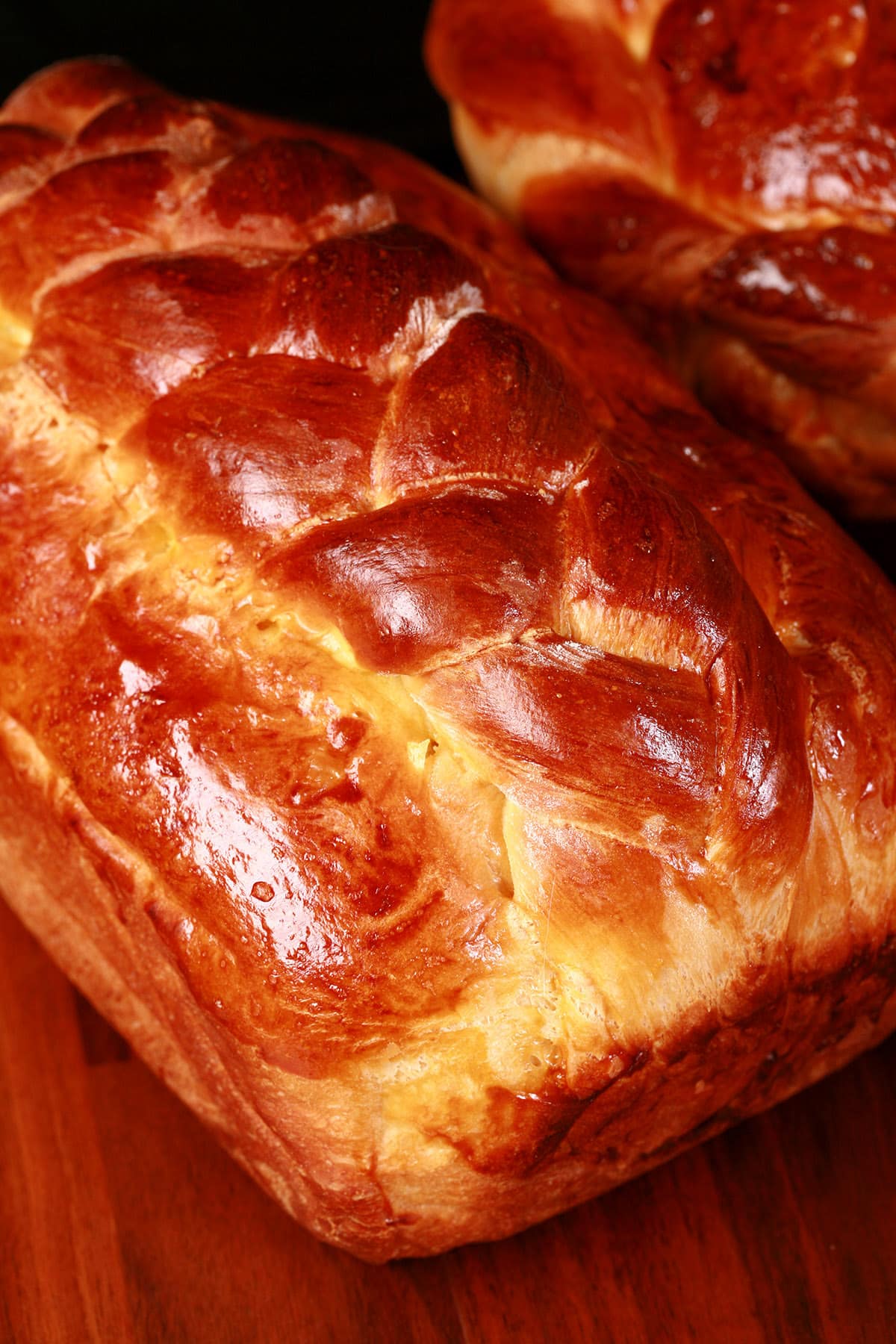
My Paska Recipe
Anyway, the memories of that bread were so vivid, when that Pysanky post brought them up, that I decided to get the original recipe from my grandmother, and make it myself for the first time.
It's always interesting when you're trying to get a recipe through a game of telephone - especially when the first two passes are through old ladies 🙂
As usual with my family, the Easter bread recipe came as more of a formula - no instructions, and some of the measurements were... not standard measurements.
It was a good start, anyway!
I adapted it a little (increased the flour and zest, changed lard to butter, ditched the coffee can in favor of decorated style), figured out what the directions would be, and made it last night.
I had planned to make this as a blog entry only, pass the finished product off to my husband to share at work, and behave myself.
Gluten allergy be damned, I dug into that sucker AS I was taking it out of the oven!
I decided that whatever fallout should happen as a result, it'll be worth it ... and it was!

Gluten Free Paska
Since originally sharing this paska bread recipe , I’ve gotten to the point where I can’t be as reckless in terms of just eating the gluten and “damn the consequences!”.
So, I finally developed a REALLY good gluten-free recipe!
It doesn’t have the same texture as this, and it’s baked up as a bundt cake. Because the batter is such that twisted dough decorations don’t really work, I went with the “glaze and sprinkles” route, and it’s fabulous.
If you know anyone who loves Ukrainian paska, but can’t handle gluten, you should definitely try it out: Gluten Free Easter Paska Bread
Note in 2022: Now I have a Keto Paska that's also gluten free!

My Gluten-Free Paska!
Paska Bread Ingredients
This bread recipe is a bit more involved than many of my bread recipes, but I promise it’s worth it! You will need:
All Purpose Flour
Granulated Sugar
Milk
Oranges & Lemons (Both juice and zest!)
Butter
Eggs*
Active Dry Yeast (You can use fresh yeast or instant yeast if you prefer)
Salt
*You’ll use both whole eggs - in the dough - and egg yolks, as the egg wash. I like to time my paska making to use the egg whites towards making Easter Pavlova.
Variations
As with most traditional recipes, there are slight differences (and sometimes not so slight!) in how people can make their paska Easter bread.
One of the big ones: Some people like to add plump raisins to the dough.
I don’t, because that’s not how Mary made it. If I were to use raisins, I’d probably use 2 cups of Golden Raisins, just for aesthetic purposes.
Dark Raisins would work just fine, though.

Equipment
There are a few pieces of equipment that you will need - or want - to make this.
1. A LARGE mixing bowl. This makes a ton of bread, so you’ll want a really big bowl to let the dough rise in. If you try to use a bowl that’s too small... you’re going to have a hard time with this 🙂
3. A Citrus Juicer. I like to use my electric Cuisinart pulp control juicer, as I’m juicing a lot of fruit when I make this!

5. Baking Pans - These can be anything. Mary used coffee cans, but I don’t tend to have tin cans on hand. I usually use a mix of loaf pans and round casserole pans. Spring form pans are also a good option, and I use foil pans when making them for others.

How to Make Paska Bread
The full recipe follows, but here’s a quick overview of what you’re looking at!
Start the Dough
I like to measure out all of the dough ingredients before getting started - it makes the whole thing go more smoothly, IMHO.
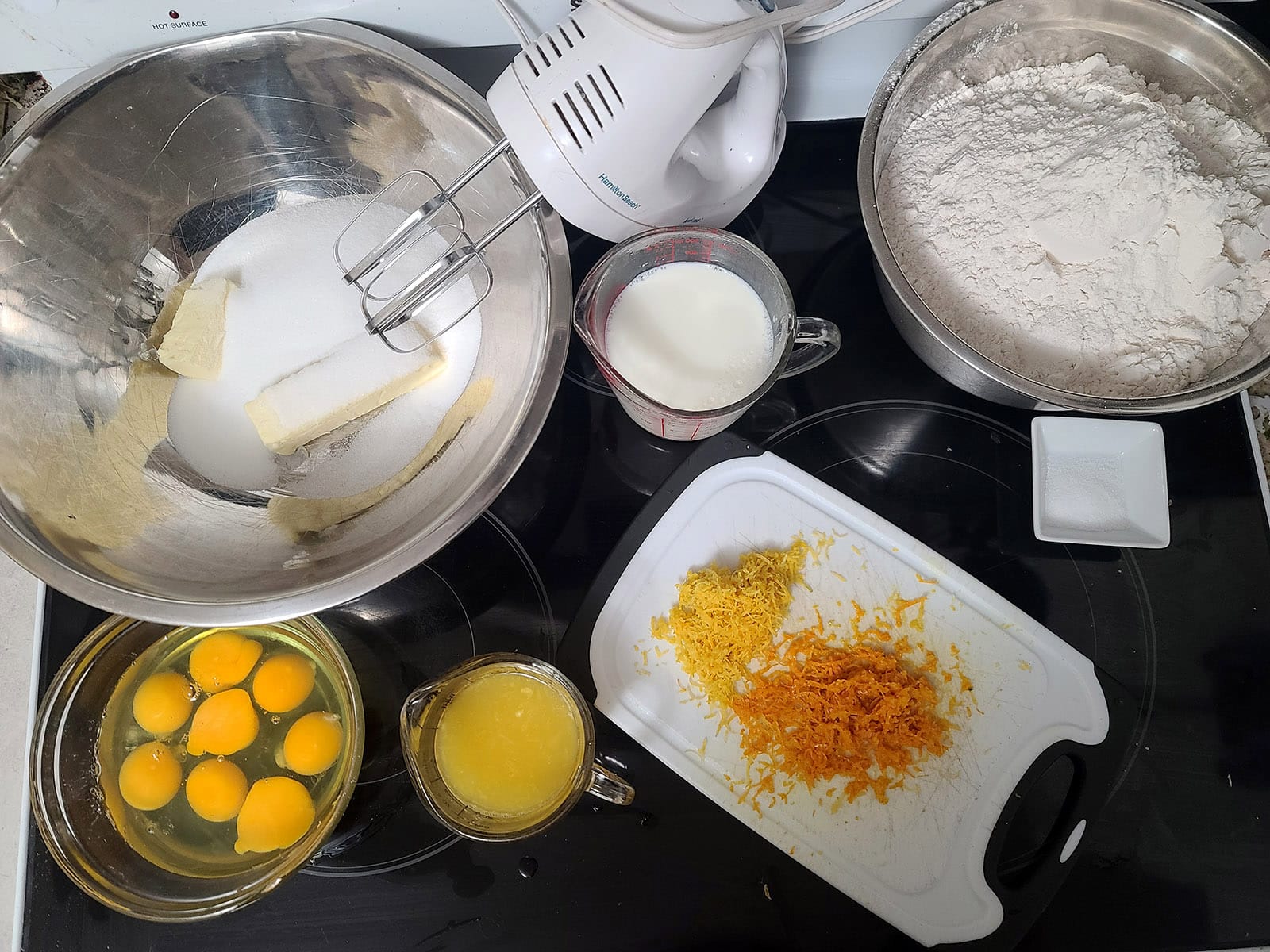
Stir sugar into warm water. Sprinkle yeast on top of sugar water, stir to gently incorporate. Allow to sit for 10-15 minutes, until bubbly.

Scrape down the sides of the bowl with a silicone spatula or wooden spoon, add eggs, continue to cream until well incorporated and smooth.
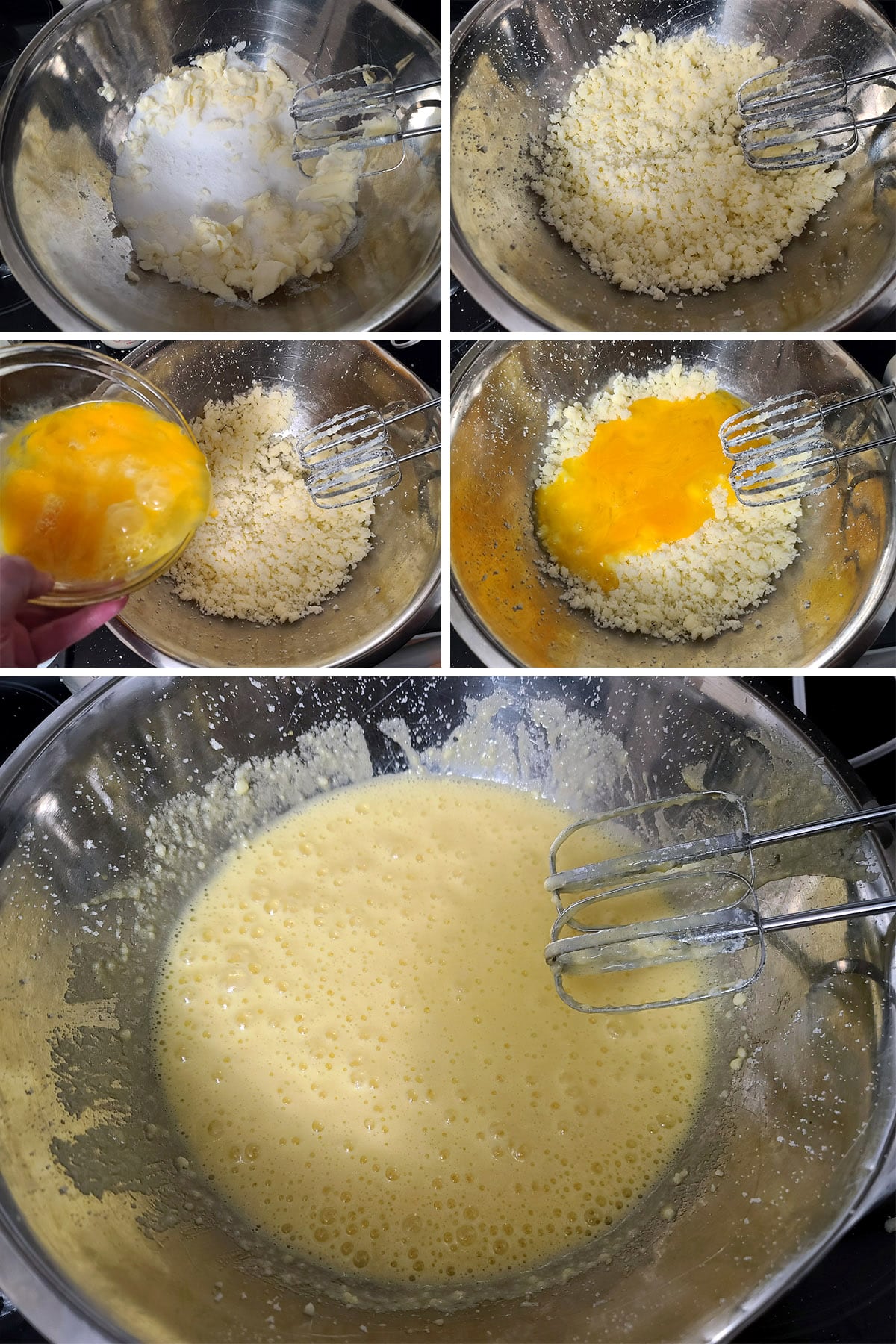
Pour in the scalded milk, continue to mix until well incorporated and smooth.

Finally, add the active yeast mixture, mix until well incorporated.
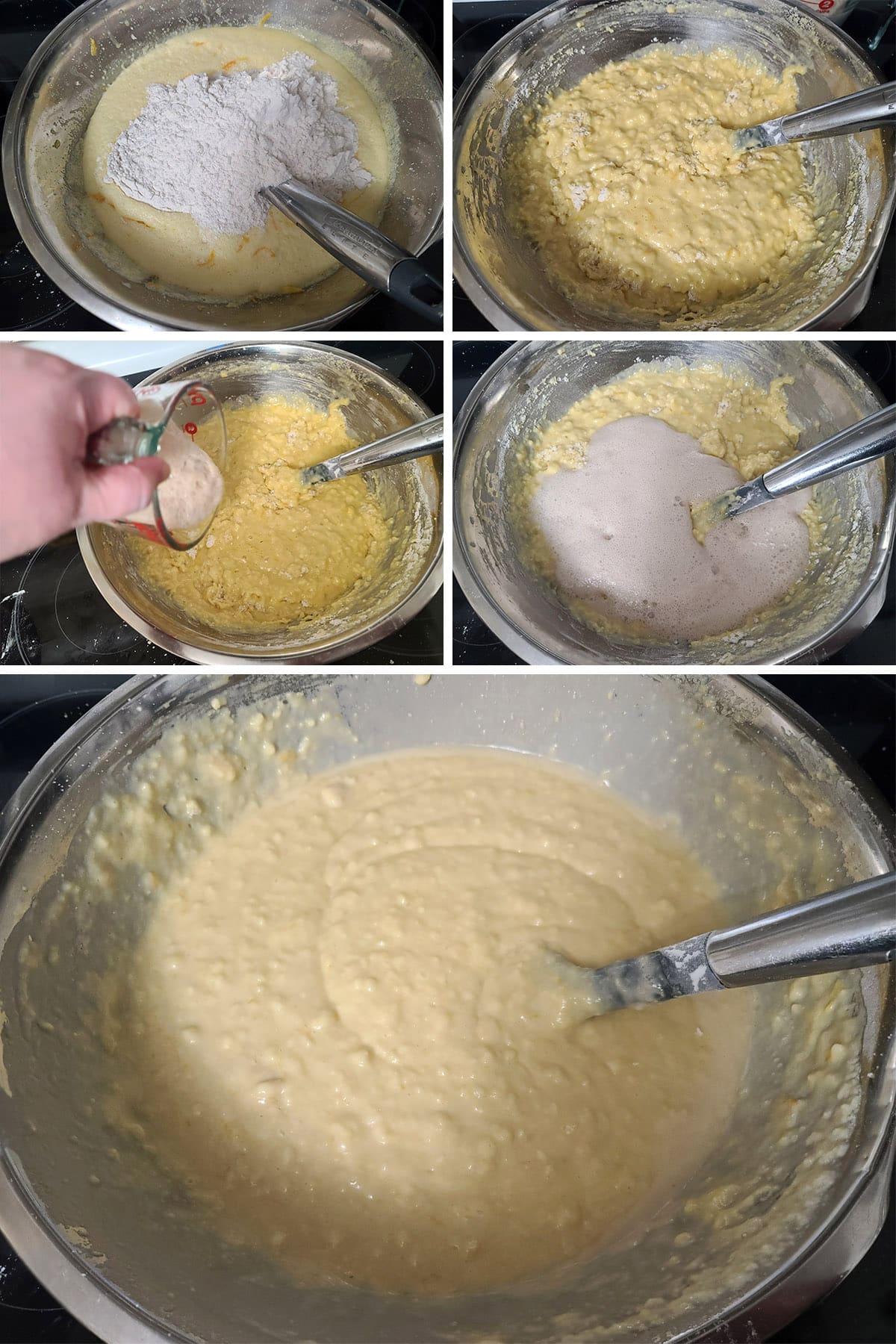
Slowly add remaining flour- mixing on a low to medium-low speed - until a good, coherent, soft smooth dough comes together. It should be only very slightly sticky to the touch – not a super sticky dough, and not really DRY.
Only add enough flour to take away excess stickiness.
Turn bread dough out onto a lightly floured surface, and knead for a few minutes. The bread dough should be smooth, elastic, and no longer sticky when it’s been kneaded enough.

I added the remaining flour to the bowl of the mixer before pouring the batter in. Usually I'll just make the whole thing in the mixer, but I wanted video 🙂
Cover bowl with plastic wrap - or a clean kitchen towel - and allow to rise in a warm spot until doubled in size, about 1 ½ hours.
Once doubled, punch dough and allow to rise another hour.

Make the Loaves
Once the second rise is done, it’s time for the fun part.
Dump the dough out on your work surface - I use a silicone mat, but a clean, lightly floured counter works, too.

For reference: to bake ONE batch of this, we generally use either:
1 - a 9″ round Pyrex dish, a large loaf pan, and 3 mini loaf pans
or
2 - A 9" Round Pyrex dish and 3 regular loaf pans
It makes a *LOT* of bread… this is a good thing!
For the main body of your breads, you’ll want the dough to fill about ⅓ of each baking pan – they’ll rise wildly. Halfway full if you’re adventurous, but don’t say I didn’t warn you.
Cover pans and reserved ⅓ dough loosely with plastic wrap and allow to rise another 30 mins.

Braids, twists, curls, crosses and rosettes are popular/traditional, but have fun with it. (Google can be a great source of design inspiration, there are a lot of different ways to decorate this bread!.)

Cover loosely with plastic, have the dough rise one last time, 30 minutes.
Bake and Eat!
While your dough is rising, whisk together the remaining egg yolks and water in a mug or small bowl, to create an egg wash.
This glaze will give your finished Paska a shiny, dark brown finish. Beautiful!
Preheat oven to 350°F.
Once final rise is finished, brush entire top of each loaf with egg wash.

If you think any of the decorations will roll, stick them in place with toothpicks!
Without opening the oven door, lower the oven temperature to 325°F and continue to bake for another 40 minutes.

I recommend wrapping and hiding a loaf or two, before cutting into any of them. If you’re planning to bring them somewhere, or share with ANYONE, this step is kind of essential.
Cut into one of your warm loaves, slather with butter, and … don’t plan on going anywhere for awhile.
It’s easy to plow through a ton of this, and it will give you a bread coma. ABSOLUTELY WORTH IT.
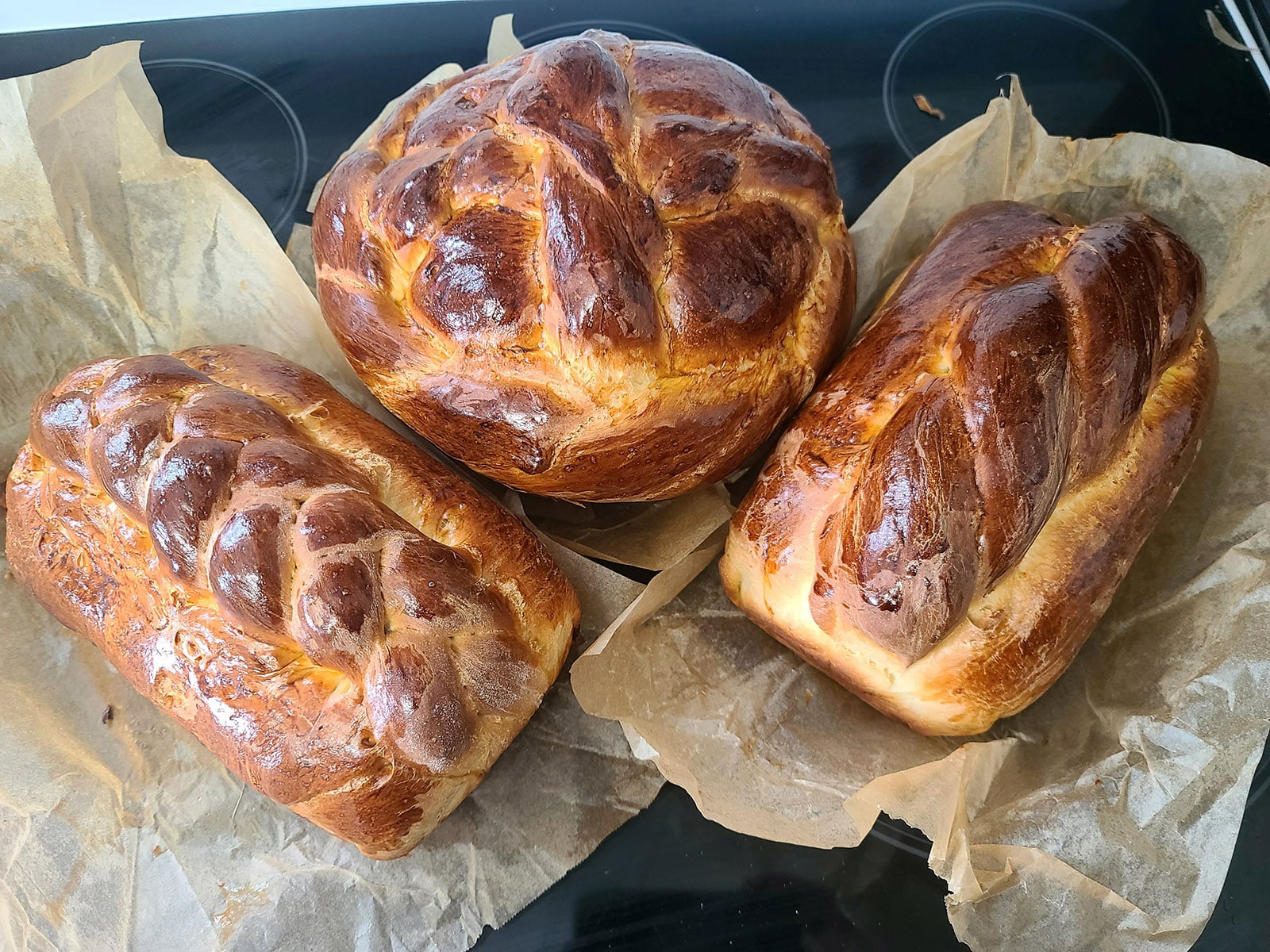
The nice thing about lining pans with parchment paper is how easy it is to lift the baked Paskas out of the pans!
Leftover Paska
While this bread is at its most fabulous when fresh out of the oven, it makes great leftovers as well.
Once the bread has fully cooled - to room temperature - wrap it in Saran wrap. It's a very tender, soft bread, so you want to be sure to keep it from drying out.
It can be stored at room temperature for up to 3 days, or in the fridge for a bit longer.
I prefer this bread served warm, either fresh out of the oven or microwaved. You’ll definitely want to heat it up if you store it in the fridge.
Once it does start to dry out a bit though?
This makes some AMAZING French toast! Add a bit of vanilla, orange zest, and a splash of OJ in the custard... MMMmmm...
If you have enough left over, it also makes a fantastic base for bread pudding. Same thing, I usually add citrus zest into the custard, and just amplify the flavours of the bread itself.

Scaling This Recipe Up
This paska recipe makes a TON of bread, so be prepared to make some friends VERY happy.
That said, once you give it out a few times, be prepared for requests. LOTS of requests!
I eventually got to the point where I was making multiple batches to handle all the friends who wanted some, and had to turn my entire kitchen into a proofing room - a warm place for the bread to rise.
I just didn’t have enough space in the oven all of that sweet dough!
So, we draped heavy plastic sheeting over the open door to the living room, lined the bowls and loaves of dough up on every flat surface, and had a space heater going. Good times, LOL.

Excuse the mess, we were still rebuilding after the tornado when this photo was taken!
Also, unless you have a large commercial mixer, I wouldn’t recommend actually doubling the recipe. It does double / triple / etc just fine, it’s just a matter of mixing it.
As-is, this batch is about as much as I’d ever recommend putting through a home stand mixer. It’s also as much as I’d recommend kneading by hand in one go.
So, I recommend making a batch, getting it through the kneading stage, putting it aside, and starting another batch... as many times as you need. (Knead? LOL)
I do streamline the ingredients part though, getting multiple bowls going with the zest, juices, etc. SO, I’ll juice and zest everything at the same time, just placing it in separate bowls. I’ll also start all the yeast off, one after another.
The dry ingredients get measured at the same time, etc - it helps to have a lot of mixing bowls if you’re going to do this!

Crappy cell phone evidence of one of my first - and smaller! - bulk paska days!
More Easter Content!
Looking for more fun / tasty ways to observe Easter? Here are a few suggestions for Easter baking and more:
Chocolate Zombie Easter Bunnies
No-Bake Easter Chocolate Pie
Easter Pavlova
Easy Pysanky [Epic Ukrainian Easter Eggs]
Gluten-Free Paska [Easter Bread]>
Layered Easter Creme Egg Brownies
Pastel Easter Charcuterie Board
Keto Paska
Paska Bagels
Southern Comfort Glazed Ham

Share the Love!
Before you chow down, be sure to take some pics of your handiwork! If you post it to Bluesky, be sure to tag us - @CelebrationGen. We're also on Pinterest, so you can save all your favourite recipes to a board!
Also, be sure to subscribe to my free monthly email newsletter, so you never miss out on any of my nonsense. Well, the published nonsense, anyway!
Finally, if you love this recipe, please consider leaving a star rating and/or a comment below, and maybe even sharing this post on social media!

Paska Bread [Ukrainian Easter Bread]
Equipment
- Zester
- Juicer
- Parchment Paper
- 5 Loaf Pans Or more, see post for suggestions.
Ingredients
- ½ cup Warm Water
- 1 teaspoon Granulated Sugar
- 2 packets Active Dry Yeast 4.5 tsp
- ¾ cup Butter softened
- 2 cups Granulated Sugar
- 8 Large Eggs beaten
- Juice of 1 lemon and 1 orange About ¾ cup juice, total.
- Zest of 1-2 lemons and 1-2 oranges
- 1 teaspoon Salt
- 1 ½ cups Scalded Milk Cooled
- 12 cups+ All Purpose Flour Divided
- 2 Large Egg Yolks
- 1 tablespoon Water
Instructions
- Stir sugar into warm water. Sprinkle yeast on top of sugar water, gently incorporate. Allow to sit for 10-15 minutes, until bubbly.
- In a stand mixer, cream together butter and sugar until fluffy. Add eggs, continue to cream until well incorporated and fluffy once more.
- Add juices, zest, and salt to the mixture, mix until combined. Add scalded milk, continue to mix until well incorporated and smooth. Add 4 cups of flour, combine well. Add yeast mixture, mix until well incorporated.
- If you have a dough hook attachment for your mixer, affix it now.
- Slowly add remaining flour until a good, coherent bread dough comes together. It should be a smooth soft dough that's only very slightly sticky to the touch – not super sticky, and not really DRY.
- Turn dough out onto a floured surface, and knead for a few minutes. Dough should be smooth, elastic, and no longer sticky when it’s been kneaded enough.
- Put dough into a lightly greased bowl or pot, cover the bowl of dough with plastic wrap, and allow to rise in a warm area until doubled in size, about 1 ½-2 hours. Once doubled, beat down the middle of the dough and allow to rise another hour.
- Reserve about ⅓ of the dough for decorations, and divide remaining dough out among the pans you’ll be using (grease them first!). For reference, we used a 9″ round pyrex pot, a large loaf pan, and 3 mini loaf pans to bake ONE batch of this. It makes a *LOT* of bread… this is a good thing!
- For the main body of your breads, you’ll want the dough to fill about ⅓ of each baking pan – they’ll rise a LOT. Halfway full if you’re adventurous, but don’t say I didn’t warn you. Cover pans and reserved ⅓ dough loosely with plastic wrap and allow to rise another 30 mins.
- Once your 30 minutes are up, use the reserved dough to make designs on the top of each loaf.Braids, twists, curls, crosses and rosettes are popular/traditional, but have fun with it. (Google can be a great source of design inspiration.) Toothpicks can be used to help secure designs in place until after baking. Cover loosely with plastic, allow to rise one last time, 30 minutes.
- While your dough is rising, whisk together the remaining egg yolks and water to create an egg wash. This glaze will give your finished Paska a shiny, dark brown finish. Beautiful!
- Preheat oven to 350°F.
- Once final rise is finished, brush entire top of each loaf with egg wash. Bake loaves for 10 minutes. Without opening the oven door, lower the heat to 325°F and continue to bake for another 40 minutes.
- Cool Paska for 10-15 minutes (if you can handle the wait), then gently remove from pans and transfer to a wire rack or wooden cutting board to continue cooling.
Video
Notes
Nutrition
More Recipes that Remind me of Gramma
Since originally writing this post, my grandma has sadly passed... but her memory lives on.
Here are a few recipes that remind me of her, whether as something she taught me to make, a replica of a retail treat we used to enjoy together, or one of my own recipes that she would request whenever I’d visit, as an adult.
Gramma's Perogies Recipe
Homemade Marshmallow Cones
Homemade Clodhoppers Candy
Puffed Wheat Squares
Honey Dill Dipping Sauce
Baking Powder Biscuits
Grandma's Potato Salad
Easy Butterfly Cupcakes
Breakfast of Champions
French Canadian Pea Soup
Beep Drink Recipe
Sponge Toffee

Older Photos
This recipe was recently updated, including new, better photos. Here are the older photos, for posterity!





A freshly designed loaf, ready for the oven!



This is how far one batch of this recipe goes!
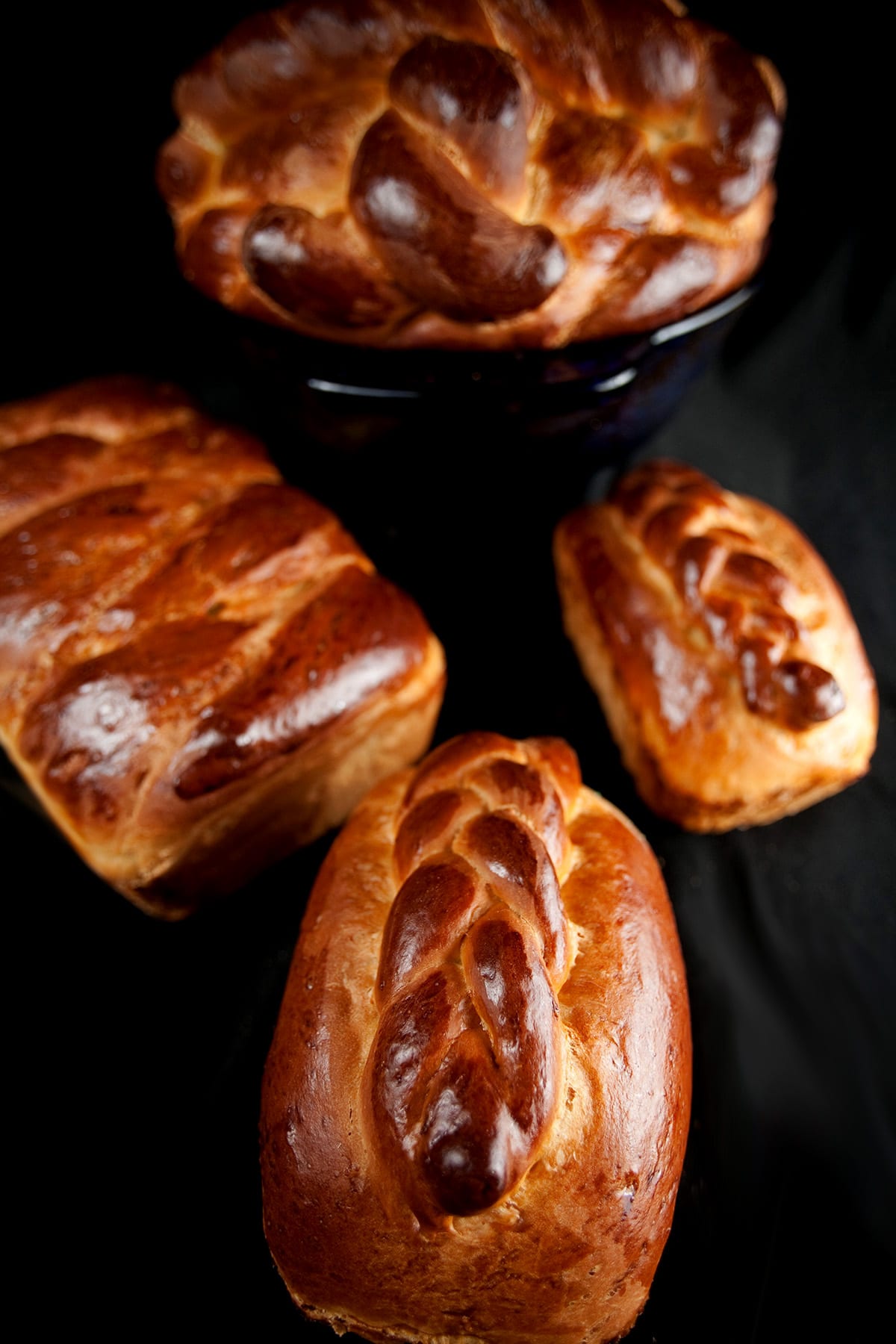














Debbie O'Brien
Oh, my... I found your blog from searching paska and I am having difficulty leaving. Between the MN ties (my husband is from upper MN), Ukranian traditions (I'm Polish), your beautiful pictures and colorful wording, I don't want to leave. Thanks for all the interesting read!!
Katie
I tried out this recipe today. Holy cow, when you said it makes a lot, you weren't kidding! I made two mini loves, one 10" tart pan, one 2-Quart bowl, one giant oval casserole dish, and one tube pan.
It just came out of the oven 20 minutes ago, and the husband and I had to test a slice (with butter, of course) even though it's bedtime. Bedtime be damned! There's paska to be eaten!
I think this recipe will be an Easter tradition from now on. Thanks so much for sharing it again on Facebook this week (http://www.facebook.com/CelebrationGeneration) -- I must have missed it the first time it appeared on your blog.
Kelly Plye
Thank you for sharing your recipe! It is delicious and perfect instructions. It was sooo hard to wait for it to get done, the smell is incredible! I will be making this for every Easter.
Tara Thronson
Would it work to half this recipe? 🙂
Marie Porter
Definitely!
Tina W
Question about the baking time. If you have the one really big loaf and 1-2 medium loaves and then the 2-3 small loaves and you cook them all the same time and temp, how to you keep the smaller items from being overbaked??
Marie Porter
I keep an eye on them and take the smaller ones out when they look done.
Michelle
This was my first time making this and decided to because my fiances family has it every Easter. He said this bread was just like how his mom used to make it. I will be making another batch tomorrow for more family members! The only thing that is different that is not in the recipe is golden raisins and saffron. I added the raisins after I separated the dough to each pan and tucked a handful in each loaf. For the saffron I added a pinch it into the bowl of 8 eggs.
Love this!!
Marie Porter
The raisins and saffron sound interesting, I may have to try that sometime. My husband has a weird aversion to raisins in baked goods, though 🙁
Dale Kalika
I also put saffron and raisins in my bread. That is how mom, grandma and great grandma always made it.
Olga
Can you estimate the volume of the juice
Marie Porter
Roughly 1/4 cup of lemon and 1/3 cup of orange
Patricia
Hi Marie. Thank you for this beautiful bread recipe! I came across it on my Pinterest feed. It is very similar to my Italian grandmothers’ Pane di Pasqua recipe. I am planning on making your Paska as well as the Italian version I make every Easter.
I have 1 question…are you able to share the dimensions of the bowls and loaf pans you used. I would like to be sure I have everything I need before starting the baking process.
Marie Porter
Honestly, it's different every time I make it, and I just grab whatever sounds good at the time.
The original recipe was just divided out into however many coffee cans she had on hand / how many loaves she needed to make, so it's not really an exact thing.
Karen
This sounds amazing and want to give it a go this weekend to test out before Easter. I do want to add some golden raisins or dried fruit - do you think a cup would be enough or more? Thanks,
Marie Porter
It's totally a matter of personal taste! I'd say 1-2 cups, depending on how much you love raisins.
Also, you might want to soak the raisins in juice or water ahead of time, so they don't dry out the bread.
Lynn
I assume this has to be baked in batches? While waiting for first to bake will the others rise too much?
Marie Porter
Depends on the sizes / shapes / pans you're doing, I usually do it all in one batch.
When I'm doing multiple batches, they ones waiting for the oven to clear don't have any issues though.
Sarah
Hi! This sounds amazing. I usually make Romanian bread for Pascha but want to try a Ukrainian recipe this year. Two questions. How does timing work for smaller loaves? Does it freeze well?
Thank you! So glad to have found your blog!
Marie Porter
We'll usually check it a few minutes earlier when the loaves are smaller, but it's a VERY forgiving recipe. I've never overcooked it yet!
As for freezing, I can't remember if I've ever frozen it, we tend to plow through it. I'm sure it would freeze well, but I'd definitely reheat it if it tastes dry or anything after freezing.
Bernice
It sounds like you went through a lot to get this Paska recipe but it was worth it in the end! The bread looks perfectly baked and with such nice designs. I was talking to a friend that mentioned coffee cans are out now because they aren't made of tin anymore. I *think* the peanut tins from Costco would make the perfect replacement, as long as the volume was similar. Is that a pyrex pie plate?
Yvonne
This is by far the BEST tasting paska I have ever have! I have a made it for the past 2 years and everyone loves it! Thank for this amazing recipe ❤️
nancy
wow this easter bread is so fluffy! I can't wait to make this again for easter holiday!
Sangeetha
Wow, Paska bread sounds like a delicious Easter treat! The combination of citrus, sugar, butter, and eggs has my mouth watering already. It's always so special when we get to enjoy traditional dishes that have been passed down through generations.
Marie-Pierre Breton
These loaves of bread look dear to your heart and delicious too! I love all the designs you made with them, and the glossy finish of the bread is precious! Great work!
Samantha Furst
Has anyone made this delicious recipe; let it proof overnight in the refrigerator, and then baked it off in the morning? If so, what step did you stop at for the night? Thanks!
Marie Porter
I haven't, but I think it would probably work.
I'd probably do the first rise, punch it down, cover it, and put it in the fridge at that point, then do the forming and following rise the next day.
Carmen
Omg I have made bread before But nothing as great as this one.now looking for more recipes like this one. Best ever! Carmen @ gmail.com
CH Homol
Love this bread. It is like my grandmother's recipe and tastes like it also. I made it for the first time. My only question, should it be a little crispy on the outside? Mine was a little crispy.
Marie Porter
I've never had it turn out crispy - Did you do the wash on it before baking?
Lori
Hi Marie,
My grandmother made her Paska in bread tins and we would often slice it, toast it and add some butter. It was so good! She did not add fruit to her Paska. Unfortunately, she kept all her recipes a secret so now we have to try multiple recipes to find something close to what she made. My father can’t remember what it tasted like (he is 89) but he remembers he loved it. I will definitely try your recipe and see what he thinks. Thanks!
Gail
Easter is coming and so is Paska, woo hoo!!!!! My mother made Paska with saffron and I would like to use saffron as well. When is the best time to add this..and how about golden raisins. Your advice would be welcomed.
Jude
Hello,
Any suggestions on baking this at higher altitude, 5,280’. Thank you.
Marie Porter
Honestly, I don't know anything at all about baking at high altitudes. Sorry about that!
Deborah
I am excited for this recipe. I didn’t have any lemons today so I just doubled the orange juice and zest. I added a splash of pure lemon extract. I also added Cardamom and nutmeg. I can’t wait for them to come out of the oven.
Cristian Riddle
I learned a few tricks here that I'll definitely use. Thanks!
Viviana Hicks
Amazing breakdown — the numbered steps made it easy to follow.